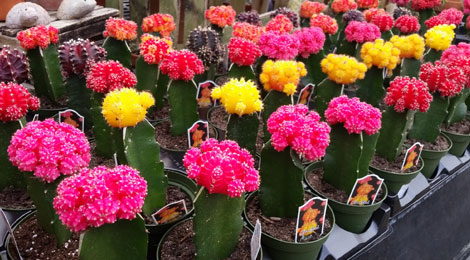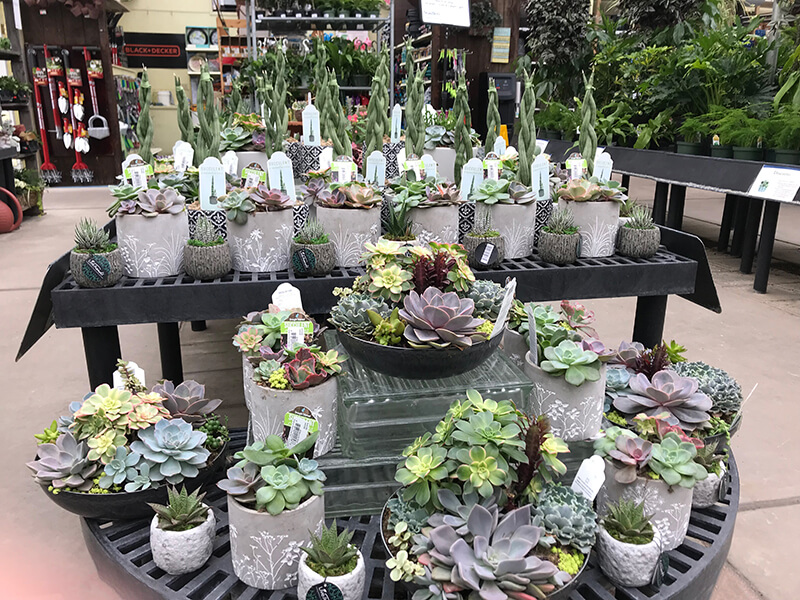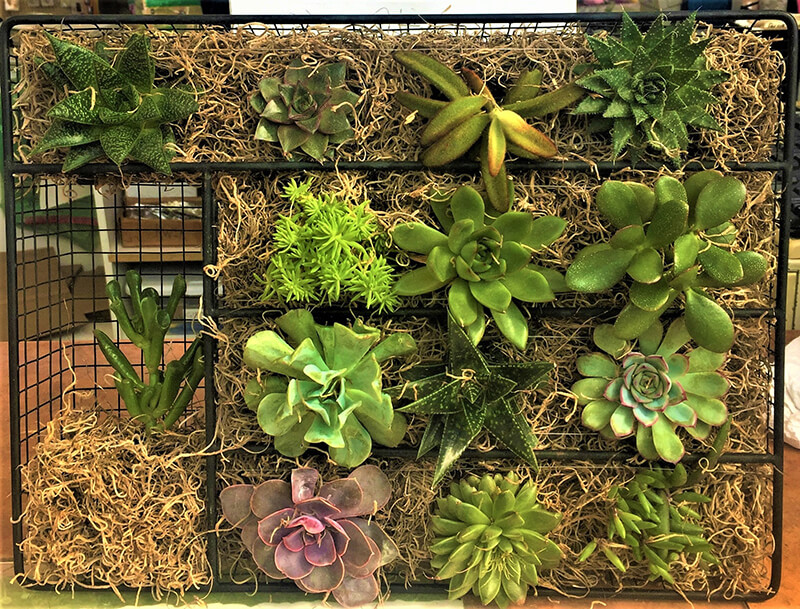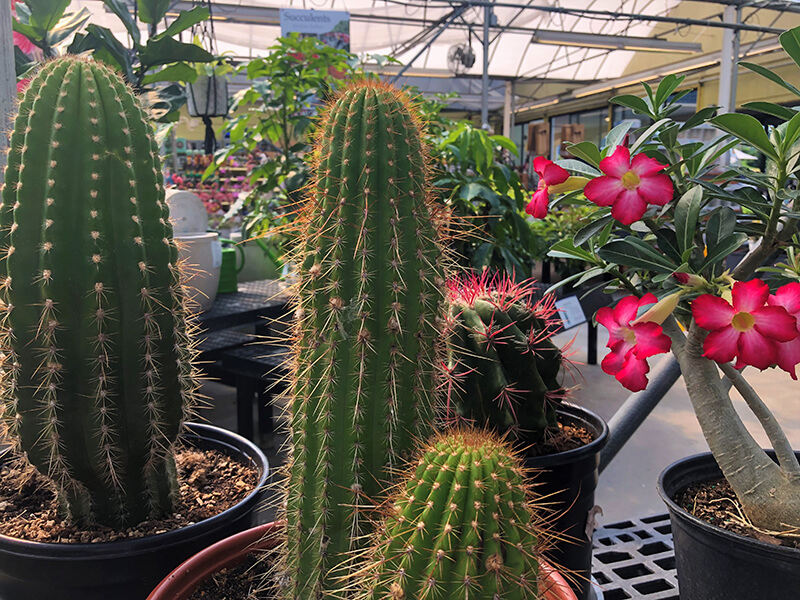How to Care for Succulents & Cacti

Many people have put off buying cacti and succulents believing that they are difficult to care for. Actually, just the opposite is true. Most are very hardy and, unlike many other houseplants, thrive on abuse! Many of these plants require minimal care and, by following just a few simple guidelines, will do well in most homes.
Water
The most frequently asked question is “How often, and how much, should they be watered?” Although a precise answer can vary from house to house, type of container potted in, heat, humidity, time of year, etc., there are only a few general rules that cover most cases. During the growing season you should water thoroughly, and then let the soil go dry before rewatering. Moisture meters help, but you can simply put your finger in the soil (not the topping) down about an inch and feel if the soil is moist. When in doubt, it is usually safer to under water than over do it. Water-storing plants can tolerate periods of dryness without harm.
Try to water when a sunny day is expected. Top watering is fine for most, but it is best to water in the morning so that the excess will evaporate in the sunlight. Be careful not to over water during the rainy season.

Light and Temperature
Most cacti and succulents need good to full sun, but there are the exceptions. These would include jungle cactus such as Schlumbergera and Rhipsalis. Certain Aloes and Haworthias do well in filtered sun also. If you have a new plant that will be going onto a hot windowsill, you may have to do this in stages to prevent burning.
As for temperature, most of these plants generally can tolerate more than we can! You will want to prevent freezing and temperatures above 95 degrees. A little known fact is that fresh air can be as important to vigorous growth as good sun!
Fertilizer
Although these plants generally need less feeding and not as often, feeding is necessary for vigorous and healthy growth. There are commercial cacti fertilizers on the market, but African Violet or blooming houseplant foods also have a good mixture. A time released fertilizer is OK. Never feed a newly purchased or freshly
transplanted cactus or succulent. Give them at least a month to acclimate to their new conditions. You’ll feed about three times a year,
but only during the growing season (summer). Remember, feeding is not a cure for an unhealthy plant. A weakened plant may even be
further damaged.

Transplanting
Unlike many foliage plants that would die if rootbound, most cacti and succulents can become grotesquely large for the container before you become embarrassed enough to transplant. A proven method with small plants would be to use tongs while larger specimens can be safely manipulated with a piece of rolled up burlap. Rose grower’s gloves have also proven very effective.
A good general soil mix would be to combine an equal weight of a commercial potting soil and a coarse grit such as Desert Dan’s True Grit. Using this same grit, or any other non-porous material (such as small stones) around the root crown, will make your plant more tolerant to over watering, prevent the growth of algae, and also look better.
There are pros and cons to using either plastic or clay. Plastic doesn’t dry out as quickly under very hot conditions, nor do nutrients tend to leach out of the sides as with clay. However, clay tends to be more tolerant to over watering. You can pretty much use whatever container you like best and then adjust watering etc. accordingly, just make sure it has a drainage hole.

Although these plants generally need less feeding and not as often, feeding is necessary for vigorous and healthy growth. There are commercial cacti fertilizers on the market, but African Violet or blooming houseplant foods also have a good mixture. In lieu of these, you can also find a good mix by looking for a low first number (the nitrogen), and a high middle number (the phosphorus). Some examples would be 5-10-5, 10-20-10, 10-20-20, or 5-10-10. Time released fertilizer is OK. Never feed a newly purchased or freshly transplanted cactus or succulent. Give them at least a month to acclimate to their new conditions. You’ll feed about three times a year, but only during the growing season (summer). Remember, feeding is not a cure for an unhealthy plant. A weakened plant may even be further damaged.
Pest Control
Like our foliage friends, cactus and succulents are prone to pests of various types. Most common are mealy bugs, aphids, white fly, scale insects, and red spiders. The best place to find an insecticide that is right for your situation is on your garden center shelf. Don’t be afraid to ask questions. There are many types available that can all work very differently. Some are safe to handle, while others are not. Individual directions must be read to see if applicable to your problem.
If you want more ways to how to get rid of pests on your plants, read our guide on ways to eradicate annoying pests on your plants.
Getting Your Plant to Flower
First you must start with a plant that is mature enough to flower. This seems like a simple enough premise, but there have been many who have expected a plant to flower before its time. The plant must be able to grow vigorously during its season, getting enough light and heat. Be careful not to feed it too much nitrogen. You must be able to make the plant recognize the proper seasons to force it into dormancy. This means reduced light, heat and watering during the winter months. In spring, all the elements mentioned must be . Fertilizing should be done with a formula high in potassium and low in nitrogen. This mix will work more for the flowers and growth. With a bit of luck, you will be rewarded with some of the most beautiful, but short-lived, of all flowers.
Visit our Greenhouses for an awesome selection of cacti, succulents, houseplants, and more! Find the store nearest you.
